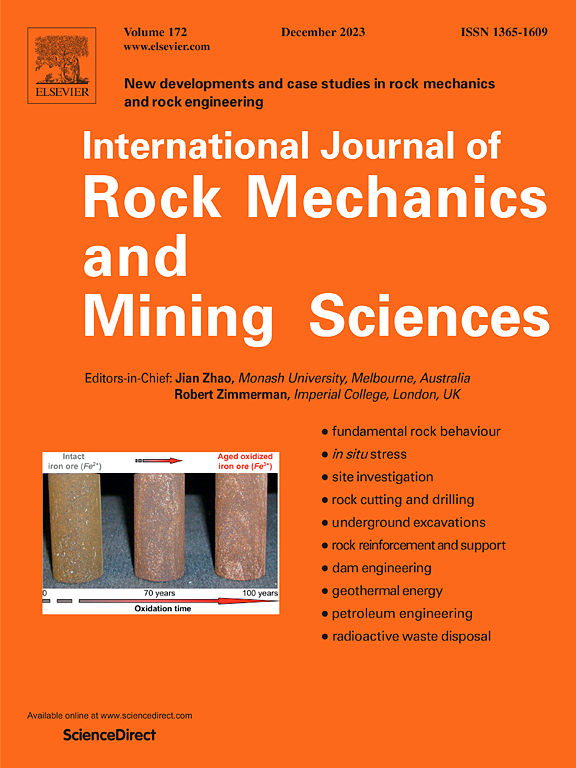Monitoring stress-induced brittle rock mass damage for preventative support maintenance
IF 7
1区 工程技术
Q1 ENGINEERING, GEOLOGICAL
International Journal of Rock Mechanics and Mining Sciences
Pub Date : 2024-11-01
DOI:10.1016/j.ijrmms.2024.105927
引用次数: 0
Abstract
Stress-induced brittle fracturing near an excavation boundary results in a volume increase, known as bulking. Excessive bulking places added demand on the rock support, which, if not detected and addressed through preventative support maintenance (i.e., proactively added reinforcement), can cause the support to fail, leading to a safety hazard and costly production delays for underground mining operations. For caving mines, these project risks are exacerbated during cave establishment due to the large abutment stress from undercutting that redistributes and concentrates stresses near excavations critical for production. This paper reports the findings from research conducted to develop and improve geotechnical monitoring practices to support preventative support maintenance in deep mining operations. This research uses a unique geotechnical monitoring database collected for the Deep Mill Level Zone panel cave mine. The data was collected across a large footprint during the mine's ramp-up period and represents an initial step toward best practices for data collection at cave mines operating in high-stress environments. Borehole camera surveys supplemented by multi-point borehole extensometers have been used to determine the depth of stress fracturing in pillar walls as a function of the distance away from the undercut. Convergence measurements and LiDAR scanning are used to characterize the corresponding rock mass bulking. The results show that the interpretation of monitoring data can be used to identify the long-term depth of stress fracturing and bulking trends in response to undercut advances. These show that direct measures of stress-induced fracturing damage provide an early indication of excavations vulnerable to bulking and that LiDAR scanning is an effective method for capturing the onset of bulking and anticipating local areas likely to experience greater deformation demand as bulking progresses. Proactive and strategic geotechnical monitoring based on the long-term depth of stress-induced fracturing trends is proposed to assist with preventative support maintenance practices.
监测应力诱发的脆性岩体破坏,进行预防性支持维护
挖掘边界附近应力引起的脆性断裂会导致体积增大,即所谓的隆起。过度膨胀会增加对岩石支护的需求,如果不通过预防性支护维护(即主动增加加固措施)来检测和解决,就会导致支护失效,给地下采矿作业带来安全隐患和代价高昂的生产延误。对于洞采矿山而言,由于下切产生的巨大支护应力会重新分布并集中在对生产至关重要的挖掘区附近,因此这些项目风险在建洞期间会进一步加剧。本文报告了为支持深部采矿作业中的预防性支护维护而开发和改进岩土工程监测方法的研究结果。这项研究使用了为深部磨矿水平区面板洞矿收集的独特岩土工程监测数据库。这些数据是在矿山提升期间在大范围内收集的,代表了在高压力环境下运营的洞穴矿山向数据收集最佳实践迈出的第一步。钻孔摄像勘测辅以多点钻孔延伸仪,用于确定支柱壁应力断裂深度与下切距离的函数关系。汇聚测量和激光雷达扫描用于确定相应岩体隆起的特征。结果表明,通过对监测数据的解释,可以确定应力断裂的长期深度以及下切推进时的隆起趋势。这些结果表明,对应力引起的断裂破坏进行直接测量,可及早发现易受隆起影响的开挖点,而激光雷达扫描则是捕捉隆起开始和预测随着隆起的推进可能出现更大变形需求的局部区域的有效方法。建议根据应力诱发断裂的长期深度趋势进行积极主动的战略性岩土工程监测,以协助开展预防性支持维护工作。
本文章由计算机程序翻译,如有差异,请以英文原文为准。
求助全文
约1分钟内获得全文
求助全文
来源期刊
CiteScore
14.00
自引率
5.60%
发文量
196
审稿时长
18 weeks
期刊介绍:
The International Journal of Rock Mechanics and Mining Sciences focuses on original research, new developments, site measurements, and case studies within the fields of rock mechanics and rock engineering. Serving as an international platform, it showcases high-quality papers addressing rock mechanics and the application of its principles and techniques in mining and civil engineering projects situated on or within rock masses. These projects encompass a wide range, including slopes, open-pit mines, quarries, shafts, tunnels, caverns, underground mines, metro systems, dams, hydro-electric stations, geothermal energy, petroleum engineering, and radioactive waste disposal. The journal welcomes submissions on various topics, with particular interest in theoretical advancements, analytical and numerical methods, rock testing, site investigation, and case studies.

 求助内容:
求助内容: 应助结果提醒方式:
应助结果提醒方式:


